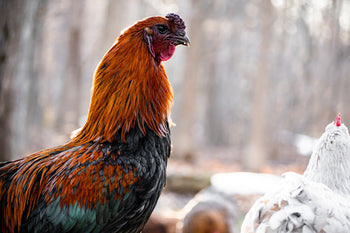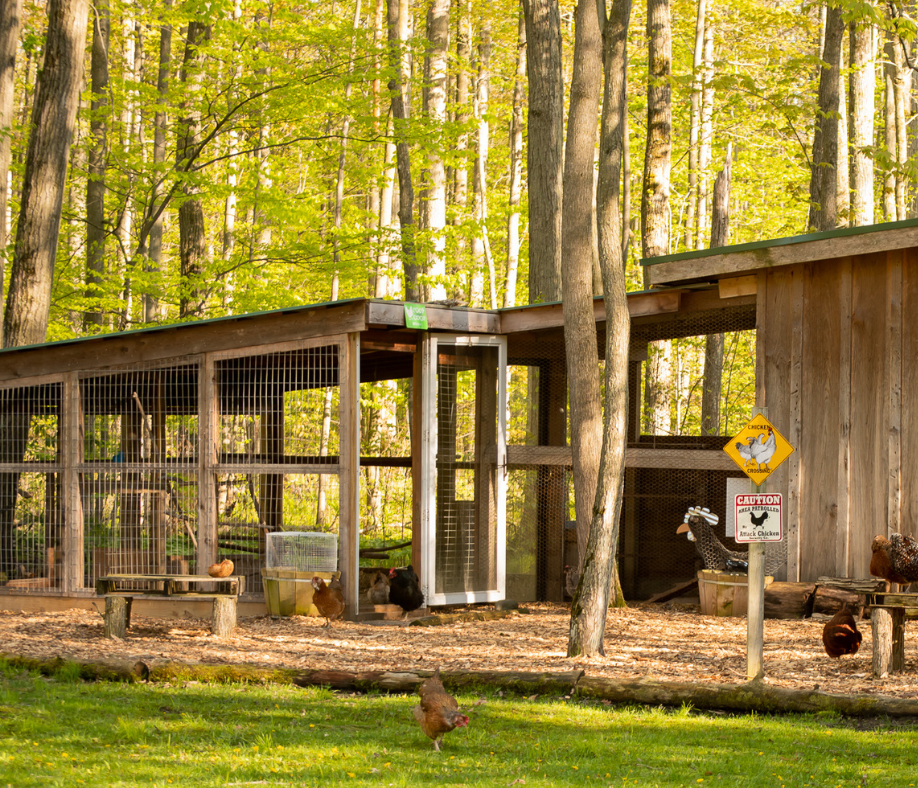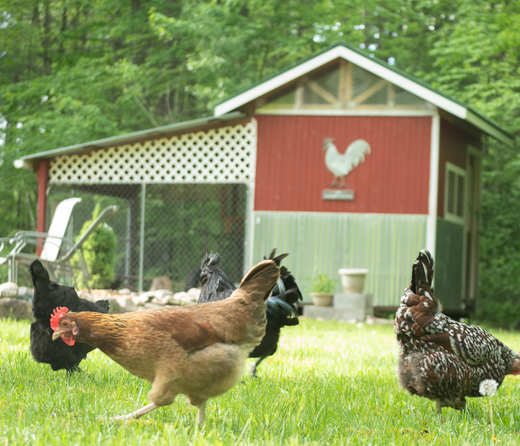Chickens are prey animals, and it seems like just about every predator has a palette for chickens or eggs. Keeping your backyard flock safe can seem daunting. However, learning how to recognize common chicken predators, knowing how they are most likely to attack, and implementing the best prevention measures for common predators in your area will help keep your flock safe.
9 Most Common Chicken Predators

#1. Canines: Domestic Dogs, Coyotes, Foxes
Domestic dogs are a common chicken predator in both rural and urban areas. You may even have a family pet who wouldn’t mind a chicken snack if given the opportunity! That’s why it is always best to try and slowly introduce your furry friend to your feathered friends as soon as possible.
Domestic dogs who are allowed to wander freely are the most dangerous to backyard flocks. Dogs often attack flocks repeatedly and can actually kill the entire flock if given the chance. Occasionally a dog will carry off some of the kill, but most domestic dogs kill for sport and not for food. Dogs may also bite, injure, or mutilate chickens without killing them.
When scouting for tracks around an attack site, dog tracks are characterized by having the hindfoot and front foot tracks offset from each other (track sizes vary depending on the size of the dog).
Coyotes and foxes are two wild canines who wouldn't miss an opportunity for a chicken snack. These two can be quite bold and may even attack when people are present or nearby. If successful, they will return for repeated attacks.
Coyotes and foxes usually only take one bird at a time and will carry off their prey for food. Foxes tend to bury their kill after carrying it away from the attack sight, leaving little evidence as they eat most of their kill. Tracks can be distinguished from dog tracks by the fact that coyotes and foxes do ‘perfect stepping’, meaning the front and hind tracks overlap.

#2. Felines: Domestic Cats & Bobcats
Not only can domestic dogs be dangerous to backyard flocks, but domestic cats can also pose a threat. Domestic cats usually only target smaller chickens, like young chicks or bantams. Sometimes domestic cats will carry off their kill and some cats will kill to eat. Skin, feathers, and even whole wings may be left at the sight of a cat attack. Domestic cat tracks are also characterized by perfect stepping, however, unlike coyotes and foxes, there will be no claw marks with the tracks since cats retract their claws when walking.
Bobcats are a wild feline to be aware of, especially in rural or sometimes even suburban areas. Bobcats usually take one to two birds per visit and will repeatably visit successful hunting grounds. They usually carry of their kill to eat and leave very little evidence behind. Bobcat tracks are larger than domestic cat tracks and they too will show no claw marks.

#3. Weasel Family: Fishers, Mink, Weasels
The weasel family includes fisher cats, mink, and weasels who will all prey on chickens if given the chance. These predators will often attack repeatably and take out as many birds as they can for sport.
Fisher cats are a member of the weasel family that are often found near water sources like lakes and rivers. You can identify a fisher cat attack as they often target the head and neck region of a chicken.
Minks are also common near water sources and they sometimes leave behind a musky scent at the scene of attack. They too will bite the head and back of the neck of a bird and will sometimes pile up their kill after an attack. Their tracks are small and resemble paw prints.
Weasels are notorious for being able to sneak through small spaces, even cracks as small as a quarter of an inch! They target the head, back of the neck, and sometimes will eat around the vent of birds they kill. Weasel tracks look like small paw prints with pointy toes.
#4. Racoons
Racoons are a widespread chicken predator and very well could be one of the most common chicken predators you’ll deal with. Racoons usually kill several birds per visit, however, they will often spread out their attacks by visiting every four to five nights. They will often carry off their kill if it is small enough, targeting the head and crop of a chicken.
Racoons can be very persistent. They are good climbers, good diggers, can figure out simple latches and door handles, and are known to injure birds through fencing.
Racoon tracks are identified by the hindfeet tracks being longer than the front feet tracks.
#5. Opossums
Opossums are also one of the most common chicken predators, usually targeting one bird per visit. They are known to bite at the legs and breast of the bird and eat the abdomen and vent of their kill. Opossums typically feast onsite rather than carry off their kill. Opossum tracks are identified by the hindfoot track having a distinct ‘thumb’ that sticks away from the rest of the track and by a ‘tail trail’ that accompanies the tracks (where the opossum’s tail brushes the ground as it walks).

#6. Snakes
Snakes rarely target mature chickens but they will prey on young chicks and eggs. They can sometimes be found resting in nesting boxes after swallowing an egg whole. If you do find a snake in your chicken coop, look for ‘slither paths’ in the dirt, mud, or sand around the chicken coop to figure out where the snake entered the coop.
To prevent snakes from stealing young chicks, raise chicks in an indoor brooder until they are old enough to be moved out to the coop. Usually once the chicks are fully feathered and no longer need an external heat source, they are too big for most snakes to swallow whole.
#7. Rats
Like snakes, rats are rarely a huge threat to adult birds, although they bite the hocks of roosted birds and sometimes pluck feathers from adult birds. Rats mostly target prey their size, namely young chicks and eggs. They take their prey whole and will leave little evidence of their attack. Signs of rat activity in the hen house include large, mouse-like droppings and tracks with a tail trail. Raise chicks in an indoor brooder to keep them safe from rats.
#8. Bear
While bears don’t often target small prey like chickens, they won’t pass up an opportunity for a chicken meal especially if they are very hungry. Black bears are the most likely species of bear to attack a flock since they adapt to living around human populations very easily. Bears usually wipe out a flock, sometimes carrying off their kill and to feast away from the scene.
Characteristics of a bear attack include damage to the chicken coop and enclosure and large bear tracks with claw marks around the scene of attack.

#9. Hawks, Raptors, & Owls
Not only do chickens get assailed from the ground, but they also have predators in the sky. Hawks, raptors, eagles, and owls will all take the opportunity to prey upon a flock. Spring and fall are the most common times for hawk and raptor attacks. The birds are looking to feed their young in the spring or stock up on reserves in the fall before winter. Birds of prey will make repeated visits after successful hunts.
Most birds of prey will target smaller chickens so they can carry off their kill. However, sights of larger kills are often characterized by lots of scattered feathers and a mutilated carcass. Hawks and raptors only take one chicken per visit, eating the breast of their kill first. Owls may take one to two birds per night and have even been known to sneak into chicken coops. They eat the head and neck of their kill and will leave talon wounds in the body. Only the large species of owls pose a threat to chickens, such as the great horned owl.
Daytime Chicken Predators vs Nighttime Chicken Predators
Learning when certain predators are most likely to attack helps to keep your flock safe at all hours of the day. Different predators have certain hunting patterns. Some prefer to hunt under the cover of darkness, while others are bold enough to attack during daylight hours. Predators can be divided into three categories: crepuscular, nocturnal, or diurnal.
Crepuscular predators will be most active at dawn and dusk. They are most likely to attack chickens first thing in the morning or right before the flock goes in to roost. Nocturnal predators are most active at night. They are the ones who will try and sneak into the chicken coop to prey on roosted chickens. They will also prey on chickens who get locked out of the coop at night. Diurnal predators are most likely to attack during the day. They are often bold and pose the most risk to free-ranging flocks.
Here are the common chicken predators listed under each category:
- Crepuscular- coyotes, foxes, bobcats, domestic cats, fisher cats, mink, weasels, opossums
- Nocturnal- racoons, opossums, rats, owls
- Diurnal- domestic dogs, bear, foxes, hawks & raptors, snakes, weasel family
How to Keep Predators out of the Chicken Coop
To keep your flock safe from all types of predators, you will need to have a predator proof chicken coop and a predator proof chicken enclosure or run. Predator proofing the chicken coop and chicken run means taking preventative measures to make it as hard as possible for predators to access your flock.
Here are some essential preventatives to include when predator proofing the chicken coop and run against these common chicken predators:
- Canines- coop skirt to prevent digging, secure latches, sturdy fencing
- Felines- predator proof windows and doors, close gaps & holes, sturdy fencing, covered enclosure to prevent climbing in
- Weasel Family- predator proof windows and doors, close gaps & holes, use ¼" hardwire cloth for fencing
- Raccoons & Opossums- tricky latches, hardwire cloth fastened with screws (not stapled), covered enclosure to prevent climbing in
- Snakes & Rats - close small gaps & holes around doors, windows, corners, & base of coop, collect eggs frequently
- Bear- strong coop and enclosure structure, electric fencing
- Hawks, Raptors, & Owls- covered enclosure and coop
To keep your flock safe from predators during all hours of the day, it is a good idea to coop train your flock so that you can securely close them in their coop at night. Coop training is also helpful for gathering up your flock if you free-range them during the day. Whether you free-range your flock or provide them access to an enclosed chicken run during the day, closing your flock up inside the coop at night is essential for preventing nocturnal predators from being enticed by a midnight chicken snack.
For a complete guide to predator proofing your chicken coop, chicken run, and chicken yard, check out this guide on How to Predator Proof a Chicken Coop!
Conclusion:
Keeping your flock off the menu may seem daunting when you know there are so many predators who enjoy a chicken snack. If you do have a predator attack, it is helpful to know how to identify the signs of common chicken predators so you can avoid repeat attacks. A predator proof chicken coop and run are essential for keeping your flock safe during all hours of the day. Make sure you lock them safely in the coop at night and allow them access to their predator proof, covered run during the day. Predator prevention measures can go a long way in keeping your flock safe and happy!










